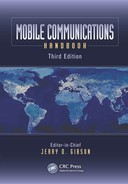Book Description
With 26 entirely new and 5 extensively revised chapters out of the total of 39, the Mobile Communications Handbook, Third Edition presents an in-depth and up-to-date overview of the full range of wireless and mobile technologies that we rely on every day. This includes, but is not limited to, everything from digital cellular mobile radio and evolving personal communication systems to wireless data and wireless networks
Illustrating the extraordinary evolution of wireless communications and networks in the last 15 years, this book is divided into five sections:
- Basic Principles provides the essential underpinnings for the wide-ranging mobile communication technologies currently in use throughout the world.
- Wireless Standards contains technical details of the standards we use every day, as well as insights into their development.
- Source Compression and Quality Assessment covers the compression techniques used to represent voice and video for transmission over mobile communications systems as well as how the delivered voice and video quality are assessed.
- Wireless Networks examines the wide range of current and developing wireless networks and wireless methodologies.
- Emerging Applications explores newly developed areas of vehicular communications and 60 GHz wireless communications.
Written by experts from industry and academia, this book provides a succinct overview of each topic, quickly bringing the reader up to date, but with sufficient detail and references to enable deeper investigations. Providing much more than a "just the facts" presentation, contributors use their experience in the field to provide insights into how each topic has emerged and to point toward forthcoming developments in mobile communications.
Table of Contents
- Cover Page
- Title Page
- Copyright Page
- Preface
- Editor
- Contributors
- I Basic Principles
- 1 The Discrete Fourier Transform
- 2 Pulse Code Modulation*
- 3 Baseband Signaling and Pulse Shaping
- 4 Complex Envelope Representations for Modulated Signals*
- 5 Modulation Methods
- 6 Error Control Coding
- 7 Information Theory
- 8 Rayleigh Fading Channels*
- 9 Channel Equalization
- 10 Echo Cancellation
- 11 Synchronization of Communication Receivers
- 12 Pseudonoise Sequences
- 13 Introduction to Spread Spectrum Systems
- 14 Signal Space
- 15 Optimum Receivers
- 16 MIMO Systems for Diversity and Interference Mitigation
- 17 High-Throughput MIMO Systems
- 18 Digital Communication System Performance*
- 19 Fundamental Limitations on Increasing Data Rate in Wireless Systems
- 20 Interference and Its Impact on System Capacity
- 21 Cell Design Principles
- II Wireless Standards
- 22 Wireless Data
- 23 Third-Generation Cellular Communications: An Air Interface Overview
- 24 3GPP LTE/LTE-Advanced Radio Access Technologies
- 25 IEEE 802.16m Radio Access Technology
- 26 Land Mobile Radio and Professional Mobile Radio: Emergency First Responder Communications
- 27 Digital Audio Broadcasting
- III Source Compression and Quality Assessment
- 28 Speech Coding for Wireless Communications
- 29 Video Compression
- 30 Machine Assessment of Speech Communication Quality
- IV Wireless Networks
- 32 Cross-Layer Design in Wireless Communications
- 33 Cooperative Communication Technologies
- 34 Cross-Layer Cooperative Communication in Wireless Networks
- 35 Wireless Mesh Networks
- 36 IP Multimedia Subsystem: Analysis of Scalability and Integration*
- 37 Cognitive Radio Networks
- V Emerging Applications
- 38 Vehicular Communications
- 39 60 GHz Wireless Communication
- glossary
- Index
